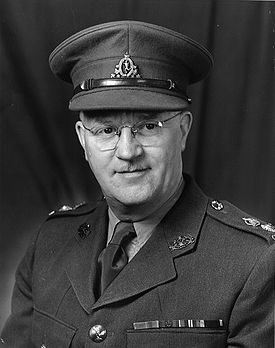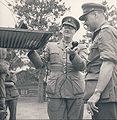Baldock, Edgar Douglas
| Edgar Douglas Baldock | |
|---|---|
| 31 May 1905 – 8 October 1977 | |
 | |
| Nickname | Doug |
| Place of birth | Portsmouth England |
| Place of death | Shea Lake Ontario |
| Allegiance | Canada |
| Service/branch | Canadian Army |
| Rank | Brigadier-General |
| Awards | MBE, EM, CD |
Brigadier-General Edgar Douglas Baldock, MBE, EM, CD (31 May 1905 - 8 October 1977) was a Canadian soldier who played a significant role with the training of the Royal Canadian Corps of Signals during the Second World War and in his support of Militia Signals.[1]
Early Years
Brigadier-General E.D. "Doug" Baldock was born in Britain in Portsmouth England on 31 May 1905, the son of Lt Comdr A. B. Baldock and Emily Baldock. He moved to Canada in 1921 and settled in Ottawa, attending Ottawa Technical High School.
Trained as a land surveyor, he entered the Public Service in 1925 and except for his active service in World War two had always been involved with mapping as a civilian career.
Service
General Baldock's military career began in 1935 when he joined 1 Corps Field Survey Company RCE (Engineers) and rose to the rank of Sergeant. He joined 3rd Divisional Signals in 1937 as a Lieutenant becoming the Technical Maintenance Officer.
On the outbreak of the War, he was one of the first to volunteer. His forte was training and he was used to the fullest extent both in Great Britain and at the Royal Canadian School of Instruction in Kingston. Through his talents many Signalmen and Officers were trained and qualified. For his service during the War, he was made a Member of the Order of the British Empire[2].
By the War's end then Major Baldock had created a record of efficiency and training second to none. He immediately transferred from the Active Force to the Militia and rejoined "3 Sigs" as Training Officer and 2I/C. Upon the death of LtCol Macbeth in 1950, Baldock took over command of the Regiment.
LCol Baldock and his Regiment collected every possible communications trophy going from the Malloch Trophy on down. The Unit's 2I/C under LtCol Baldock, Major Wilfred "Wilf" Egan, himself an officer of military distinction (Military Cross for Bravery) gave credit to him as a hard taskmaster but one who could do it effectively and keep moral high. It was through these persistent efforts and discipline that he, along with Macbeth, rebuilt the Regiment.
In 1955 he was made a Staff Officer and later the 12 Militia Group Commander attaining the rank of Brigadier-General.
Retirement Years
Brigadier General Baldock retired from Active Service in 1960 but he wasn't away long. He became more actively involved in the Canadian Signals Association and held various offices in the Association, primarily executive secretary, as well as in the Conference of Defence Associations. In these capacities he tried to lobby for the betterment of all Signals units. When in 1969 the Militia because of reorganization determined that they did not require the services of the Signals Militia, and that all Signals units across the country were to be disbanded (with the exception of a squadron in London and Sherbrooke) the Signals Association led by Baldock and BGen Beament were able to salvage these units and to form the Communication Reserve. Without these two gentlemen and their clout there would be neither Communication Reserve nor any Signals Militia.
Brigadier-General Baldock created the Signals Book of Remembrance honoring the fallen in WWI, WWII, Korea and Peacekeeping.
He served as the the Honorary Lieutenant Colonel of 3rd Signal Regiment starting in 1963 and, in 1966 he became the unit's Honorary Colonel.
He died at age 72 on 8 October 1977 at his Shea Lake cottage, leaving his wife, five children, 18 grand children and one great grandchild.









